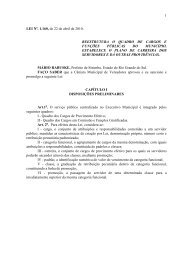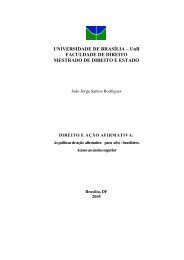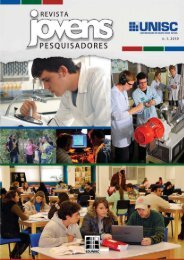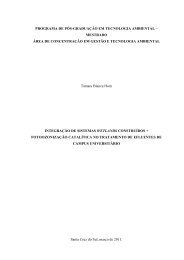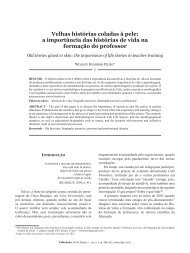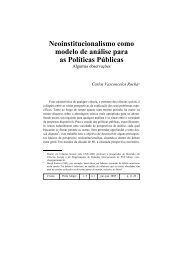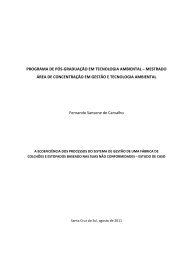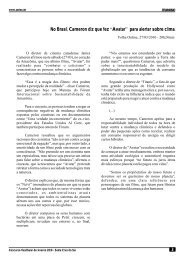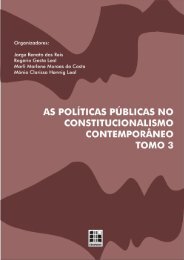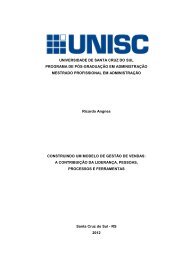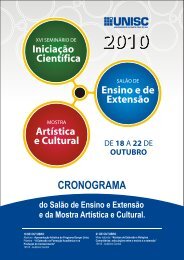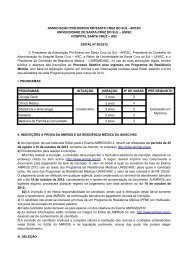Prova Completa - Unisc
Prova Completa - Unisc
Prova Completa - Unisc
You also want an ePaper? Increase the reach of your titles
YUMPU automatically turns print PDFs into web optimized ePapers that Google loves.
11 Escolha a alternativa que melhor traduz as )<br />
metáforas do poema de Ferreira Gullar apresentado na<br />
questão 10.<br />
a) “E a poesia vai à esquina comprar jornal.” A poesia<br />
documenta as coisas rotineiras.<br />
b) “A poesia ri.” A poesia está acima do debate político e<br />
teórico acerca de si mesma.<br />
5<br />
c) “Cientistas esquartejam Puchkin e Baudelaire.” Os<br />
poetas são massacrados pela crítica.<br />
d) “Não tem passado nem futuro.” A poesia não está<br />
condicionada à biografia dos poetas.<br />
e) “Não sabe a fel nem sabe a mel: É de papel.” A poesia 10<br />
sempre mostra o lado doce e amargo da vida.<br />
12 Pablo Neruda, poeta chileno, é o personagem<br />
principal de O carteiro e o poeta, romance de Antonio<br />
Skármeta. No trecho abaixo, o poeta conversa com o<br />
carteiro, que acabara de entregar-lhe a correspondência:<br />
“- Como é, dom Pablo?!<br />
- Metáforas, homem!<br />
- Que são essas coisas?<br />
O poeta colocou a mão sobre o ombro do rapaz.<br />
- Para esclarecer mais ou menos de maneira imprecisa,<br />
são modos de dizer uma coisa comparando com outra.<br />
- Dê-me um exemplo...<br />
Neruda olhou o relógio e suspirou.<br />
- Bem, quando você diz que o céu está chorando. O que é<br />
que você quer dizer com isto?<br />
- Ora, fácil! Que está chovendo, ué!<br />
- Bem, isso é uma metáfora.<br />
- E por que se chama tão complicado, se é uma coisa tão<br />
fácil?<br />
- Porque os nomes não têm nada a ver com a<br />
simplicidade ou complexidade das coisas. Pela sua<br />
teoria, uma coisa pequena que voa não deveria ter um<br />
nome tão grande como mariposa. Elefante tem a mesma<br />
quantidade de letras que mariposa, é muito maior e não<br />
voa – concluiu Neruda, exausto. Com um resto de ânimo<br />
indicou ao solícito Mario o rumo da enseada. Mas o<br />
carteiro teve a presença de espírito de dizer:<br />
- Puxa, eu bem que gostaria de ser poeta!”<br />
(SKÁRMETA, Antonio. O carteiro e o poeta. Tradução de Beatriz<br />
Sidou para Ardiente paciência, 1985. Rio de Janeiro: Record, 1996)<br />
Escolha a alternativa que não interpreta corretamente<br />
o texto.<br />
a) Mario deseja ser poeta para brincar com a linguagem.<br />
b) Neruda explica que os nomes das coisas não precisam<br />
ter relação com seus atributos.<br />
c) Neruda parecia estar preocupado com o tempo que<br />
dispensava à conversa.<br />
d) Chuva, mariposa e elefantes são metáforas.<br />
e) As metáforas podem expressar sentidos pela comparação.<br />
15<br />
20<br />
25<br />
30<br />
35<br />
40<br />
45<br />
50<br />
Inglês<br />
Greenhouse gases arise from a wide range of<br />
sources and their increasing concentration is largely<br />
related to the compound effects of increased<br />
population, improved living standards and changes<br />
in lifestyle. From a current base of 5 billion, the<br />
United Nations predicts that the global population<br />
may stabilise in the twenty-first century between 8<br />
and 14 billion, with more than 90 per cent of the<br />
projected increase taking place in the world's<br />
developing nations. The associated activities to<br />
support that growth, particularly to produce the<br />
required energy and food, will cause further<br />
increases in greenhouse gas emissions. The<br />
challenge, therefore, is to attain a sustainable<br />
balance between population, economic growth and<br />
the environment.<br />
The major greenhouse gas emissions from<br />
human activities are carbon dioxide (CO2),<br />
methane and nitrous oxide. Chlorofluorocarbons<br />
(CFCs) are the only major contributor to the<br />
greenhouse effect that does not occur naturally,<br />
coming from such sources as refrigeration, plastics<br />
and manufacture. Coal’s total contribution to<br />
greenhouse gas emissions is thought to be about 18<br />
per cent, with about half of this coming from<br />
electricity generation.<br />
The worldwide coal industry allocates<br />
extensive resources to researching and developing<br />
new technologies and ways of capturing greenhouse<br />
gases. Efficiencies are likely to be improved<br />
dramatically, and hence CO2 emissions reduced,<br />
through combustion and gasification techniques<br />
which are now at pilot and demonstration stages.<br />
Clean coal is another avenue for improving fuel<br />
conversion efficiency. Investigations are under way<br />
into super-clean coal (35 per cent ash) and<br />
ultraclean coal (less than 1 per cent ash). Superclean<br />
coal has the potential to enhance the<br />
combustion efficiency of conventional pulverised<br />
fuel power plants. Ultraclean coal will enable coal<br />
to be used in advanced power systems such as<br />
coal-fired gas turbines which, when operated in<br />
combined cycle, have the potential to achieve much<br />
greater efficiencies.<br />
Defendants of mining point out that,<br />
environmentally, coal mining has two important<br />
factors in its favour. It makes only temporary use of<br />
the land and produces no toxic chemical wastes. By<br />
carefully preplanning projects, implementing<br />
pollution control measures, monitoring the effects<br />
of mining and rehabilitating mined areas, the coal<br />
industry minimises the impact on the neighbouring<br />
community, the immediate environment and longterm<br />
land capability.<br />
Concurso Vestibular de Verão 2013 - Santa Cruz do Sul, Capão da Canoa, Montenegro, Sobradinho e Venâncio Aires



